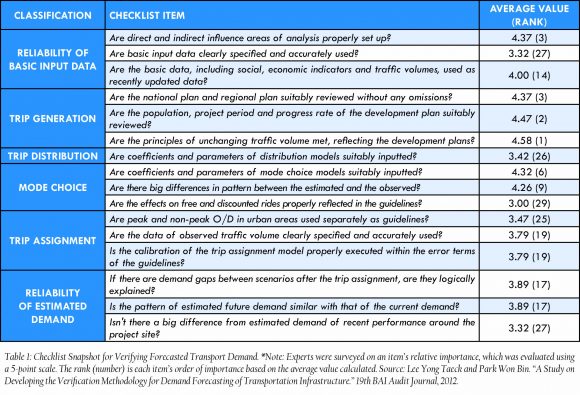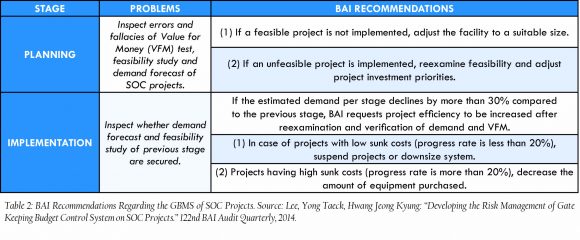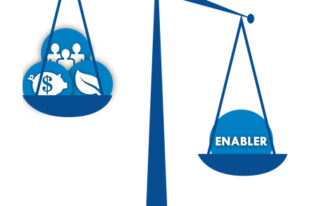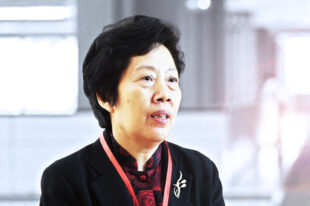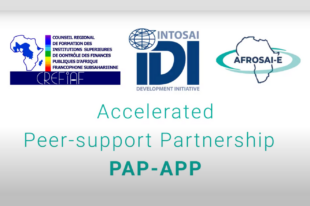Applying Lessons Learned to Increase Integrity, Transparency

by Lee Yong-taeck, Hwang Jeong-kyeong, Kim Kye-joong, Board of Audit and Inspection, Republic of Korea
Introduction
In 2016, Korea spent approximately 25 trillion won on Social Overhead Capital (SOC), which equates to roughly 15% of the central government’s budget. The SOC is defined as 46 specified infrastructure projects—roads, railroads, harbors, dams and schools.
These projects, major sources of financial burdens to administrative agencies, have demonstrated, through several studies, overestimated demand forecasts and underestimated costs. In an effort to combat these problems, the Korean government developed the Gateway Budget Management System (GBMS).
The GBMS, implemented in1999, aimed to verify project feasibility throughout the project’s lifecycle; however, recent Board of Audit and Inspection (BAI) audit reports, noted that, despite GBMS use, impractical projects still existed, resulting in a repeated waste of funds.
The BAI conducted inspections on past projects, practices and processes to examine whether or not the GBMS was efficiently operating and whether or not project feasibility risk factors were being well managed.
The Audit Approach
Development of Objective Audit Methodologies
The BAI developed a checklist (see Table 1: Checklist Snapshot for Verifying Forecasted Transport Demand) to verify the demand forecasting model at each stage of a project. The checklist’s items (29 in total) were derived from scientific investigation analysis methods, including a survey of experts from the Korean Society of Transportation. The approach included the application of the checklist to individual projects along with the use of peer reviews to verify findings.
The Recommendations
Based on audit findings, the BAI provided clear and detailed recommendations to be implemented throughout the planning and implementation stages (see Table 2 on page 25: BAI Recommendations Regarding the GBMS of SOC Projects). These recommendations, which the BAI suggested be applied consistently, included facility sizing, investment prioritization and system downsizing.
Efforts to Manage Systematic Risks
The BAI noted four risk factors (technical, social and economic, political, ethical) causing GBMS error or fallacies and introduced concrete risk management methods to optimally manage these risk factors (see Table 3: Reaction Methods of Risk Factors Causing GBMS Errors or Fallacies).
Efforts to Secure Audit Effectiveness
The BAI has made efforts to secure audit effectiveness by following up on audit recommendations to discover whether audited organizations are executing the requested measures. If the audited organization has not taken necessary actions, the BAI intends to repeatedly request BAI recommendation compliance.
Conclusion
Infeasible SOC projects can lead to an operating deficit, as well as capital cost waste. The BAI’s audit approach to more effectively use the GBMS for SOC projects can be summarized as follows:
First, it is important to improve the professional skills of auditors and develop sound audit methodologies, as audit practices require a high level of professionalism. Professionalization also (1) increases audit reliability by enhancing audit acceptance from audited organizations; (2) improves audit transparency by establishing objective audits and inspection methodologies in partnership with external professionals; and (3) develops systematic audit approaches that include joint inspections or peer reviews.
Second, the BAI attempted to provide audited organizations with consistent recommendations and to act as the GBMS project assurance institution. This may require establishing feasibility guidelines; upgrading basic database input; introducing advanced project assurance schemes; and assuring the efficient execution of individual projects.
Third, the BAI attempted to build systematic risk management methods for all risk factors typically causing errors and fallacies. These methods will enable optimum responses to technical, social and economic, political, and ethical risks.
Finally, the BAI’s recommendations are checked and consistently tracked through recommendation management and follow-up audits. The BAI will continue conducting audits based on objective audit techniques and auditor professionalism to ensure integrity and transparency as Korea’s GBMS project assurance institution.

